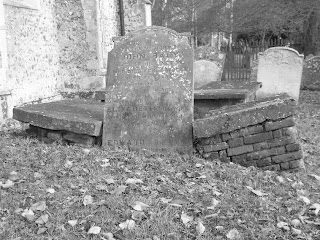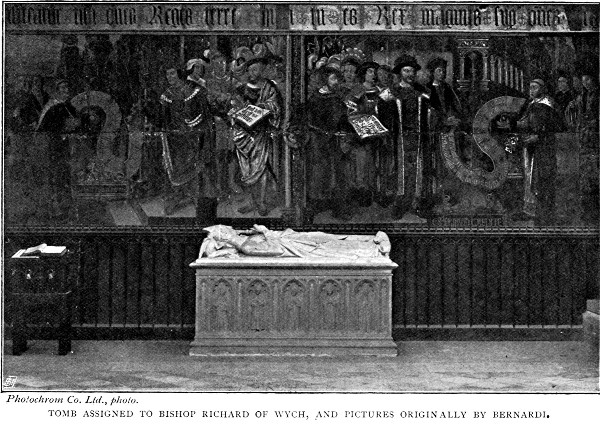 |
| Sir Thomas Browne |
THE solemnities, ceremonies, rites of their cremation or interment, so solemnly delivered by authors, we shall not disparage our reader to repeat. Only the last and lasting part in their urns, collected bones and ashes, we cannot wholly omit or decline that subject, which occasion lately presented, in some discovered among us.
In a field of Old Walsingham, not many months past, were digged up between forty and fifty urns, deposited in a dry and sandy soil, not a yard deep, nor far from one another. Not all strictly of one figure, but most answering these described; some containing two pounds of bones, and teeth, with fresh impressions of their com- bustion; besides the extraneous substances, like pieces of small boxes, or combs handsomely wrought, handles of small brass instruments, brazen nippers, and in one some kind of opal.
Near the same plot of ground, for about six yards compass, were digged up coals and incinerated substances, which begat conjecture that this was the or place of burning their bodies, or some sacrificing place unto the which was properly below the surface of the ground, as the and altars unto the gods and heroes above it.
 |
© Godric Godricson
|
That these were the urns of Romans from the common custom and place where they were found, is no obscure conjecture, not far from a Roman garrison, and but five miles from Brancaster, set down by ancient record under the name of Branodunum. And where the adjoining town, containing seven parishes, in no very different sound, but Saxon termination, still retains the name of Burnham, which being an early station, it is not im- probable the neighbour parts were filled with habitations, either of Romans themselves, or Britons Romanized, which observed the Roman customs.
Nor is it improbable, that the Romans early possessed this country. For though we meet not with such strict particulars of these parts before the new institution of Constantine and military charge of the count of the Saxon shore, and that about the Saxon invasions, the Dalmatian horsemen were in the garrison of Brancaster; yet in the time of Claudius, Vespasian, and Severus, we find no less than three legions dispersed through the province of Britain. And as high as the reign of Claudius a great overthrow was given unto the Iceni, by the Roman lieutenant Ostorius. Not long after, the country was so molested, that, in hope of a better state, Prastaagus bequeathed his kingdom unto Nero and his daughters; and Boadicea, his queen, fought the last decisive battle with Paulinus. After which time, and conquest of Agricola, the lieutenant of Vespasian, pro- bable it is, they wholly possessed this country; ordering it into garrisons or habitations best suitable with their securities. And so some Roman habitations not im- probable in these parts, as high as the time of Vespasian, where the Saxons after seated, in whose thin-filled maps we yet find the name of Walsingham. Now if the Iceni were but Gammadims, Anconians, or men that lived in an angle, wedge, or elbow of Britain, according to the original etymology, this country will challenge the emphatical appellation, as most properly making the elbow or of Icenia.
That Britain was notably populous is undeniable, from that expression of Caesar. That the Romans themselves were early in no small numbers—seventy thousand, with their associates, slain, by Boadicea, affords a sure account. And though not many Roman habitations are now known, yet some, by old works, rampiers, coins, and urns, do testify their possessions. Some urns have been found at Castor, some also about Southcreak, and, not many years past, no less than ten in a field at Buston, not near any recorded garrison. Nor is it strange to find Roman coins of copper and silver among us; of Vespasian, Trajan, Adrian, Commodus, Antoninus, Severus, &c.; but the greater number of Dio- clesian, Constantine, Constans, Valens, with many of Victorinus Posthumius, Tetricus, and the thirty tyrants in the reign of Gallienus; and some as high as Adrianus have been found about Thetford, or Sitomagus, mentioned in the of Antoninus, as the way from Venta or Castor unto London. But the most frequent discovery is made at the two Castors by Norwich and Yarmouth at Burghcastle, and Brancaster. Besides the Norman, Saxon, and Danish pieces of Cuthred, Canutus, William, Matilda, and others, some British coins of gold have been dispersedly found, and no small number of silver pieces near Norwich, with a rude head upon the obverse, and an ill-formed horse on the reverse, with inscriptions whether implying Iceni, Durotriges, Tascia, or Trinobantes, we leave to higher conjecture. Vulgar chronology will have Norwich Castle as old as Julius Caesar; but his distance from these parts, and its Gothick form of structure, abridgeth such antiquity. The British coins afford conjecture of early habitation in these parts ficia fere Gallicis consimilia."Caesar de Bello. though the city of Norwich arose from the ruins of Venta; and though, perhaps, not without some habi- tation before, was enlarged, builded, and nominated by the Saxons. In what bulk or populosity it stood in the old East-Angle monarchy tradition and history are silent. Considerable it was in the Danish eruptions, when Sueno burnt Thetford and Norwich, and Ulfketel, the governor thereof, was able to make some resistance, and after endeavoured to burn the Danish navy.
 |
© Godric Godricson
|
How the Romans left so many coins in countries of their conquests seems of hard resolution; except we consider how they buried them under ground when, upon barbarous invasions, they were fain to desert their habitations in most part of their empire, and the strict- ness of their laws forbidding to transfer them to any other uses: wherein the Spartans were singular, who, to make their copper money useless, contempered it with vinegar. That the Britons left any, some wonder, since their money was iron and iron rings before Caesar; and those of after-stamp by permission, and but small in bulk and bigness. That so few of the Saxons remain, because, overcome by succeeding conquerors upon the place, their coins, by degrees, passed into other stamps and the marks of after-ages.
Than the time of these urns deposited, or precise antiquity of these relicks, nothing of more uncertainty; for since the lieutenant of Claudius seems to have made the first progress into these parts, since Boadicea was overthrown by the forces of Nero, and Agricola put a full end to these conquests, it is not probable the country was fully garrisoned or planted before; and, therefore, however these urns might be of later date, not likely of higher antiquity.
And the succeeding emperors desisted not from their conquests in these and other parts, as testified by history and medal-inscription yet extant: the province of Britain, in so divided a distance from Rome, beholding the faces of many imperial persons, and in large account; no fewer than Caesar, Claudius, Britannicus, Vespasian, Titus, Adrian, Severus, Commodus, Geta, and Caracalla.
A great obscurity herein, because no medal or em- peror's coin enclosed, which might denote the date of their interments; observable in many urns, and found in those of Spitalfields, by London, which contained the coins of Claudius, Vespasian, Commodus, Antoninus, attended with lacrymatories, lamps, bottles of liquor, and other appurtenances of affectionate superstition, which in these rural interments were wanting.
 |
© Godric Godricson
|
Some uncertainty there is from the period or term of burning, or the cessation of that practice. Macrobius affirmeth it was disused in his days; but most agree, though without authentic record, that it ceased with the Antonini, most safely to be understood after the reign of those emperors which assumed the name of Antoninus, extending unto Heliogabalus. Not strictly after Marcus; for about fifty years later, we find the magnificent burning and consecration of Servus; and, if we so fix this period or cessation, these urns will challenge above thirteen hundred years.
But whether this practice was only then left by emperors and great persons, or generally about Rome, and not in other provinces, we hold no authentic account; for after Tertullian, in the days of Minucius, it was obviously objected upon Christians, that they con- demned the practice of burning. And we find a passage in Sidonius, which asserteth that practice in France unto a lower account. And, perhaps, not fully disused till Christianity fully established, which gave the final extinction to these sepulchral bonfires.
Whether they were the bones of men, or women, or children, no authentic decision from ancient custom in distinct places of burial. Although not improbably conjectured, that the double sepulture, or burying-place of Abraham, had in it such intention. But from exility of bones, thinness of skulls, smallness of teeth, ribs, and thigh-bones, not improbable that many thereof were persons of minor age, or woman. Confirmable also from things contained in them. In most were found sub- stances resembling combs, plates like boxes, fastened with iron pins, and handsomely overwrought like the necks or bridges of musical instruments; long brass plates overwrought like the handles of neat implements; brazen nippers, to pull away hair; and in one a kind of opal, yet maintaining a bluish colour.
Now that they accustomed to burn or bury with them, things wherein they excelled, delighted, or which were dear unto them, either as farewells unto all pleasure, or vain apprehension that they might use them in the other world, is testified by all antiquity, observable from the gem or beryl ring upon the finger of Cynthia, the mistress of Propertius, when after her funeral pyre her ghost appeared unto him; and notably illustrated from the contents of that Roman urn preserved by Cardinal Farnese, wherein besides great number of gems with heads of gods and goddesses, were found an ape of agath, a grasshopper, an elephant of amber, a crystal ball, three glasses, two spoons, and six nuts of crystal; and beyond the content of urns, in the monu- ment of Childerek the first, and fourth king from Pharamond, casually discovered three years past at Tournay, restoring unto the world much gold richly adorning his sword, two hundred rubies, many hundred imperial coins, three hundred golden bees, the bones and horse-shoes of his horse interred with him, accord- ing to the barbarous magnificence of those days in their sepulchral obsequies. Although, if we steer by the conjecture of many a Septuagint expression, some trace thereof may be found even with the ancient Hebrews, not only from the sepulchral treasure of David, but the circumcision knives which Joshua also buried.
Some men, considering the contents of these urns, lasting pieces and toys included in them, and the custom of burning with many other nations, might somewhat doubt whether all urns found among us, were properly Roman relicks, or some not belonging unto our British, Saxon, or Danish forefathers.
 |
© Godric Godricson
|
In the form of burial among the ancient Britons, the large discourses of Caesar, Tacitus, and Strabo are silent. For the discovery whereof, with other particulars, we much deplore the loss of that letter which Cicero expected or received from his brother Quintus, as a resolution of British customs; or the account which might have been made by Scribonius Largus, the physician, accompanying the Emperor Claudius, who might have also discovered that frugal bit of the old Britons, which in the bigness of a bean could satisfy their thirst and hunger.
But that the Druids and ruling priests used to burn and bury, is expressed by Pomponius; that Bellinus, the brother of Brennus, and King of the Britons, was burnt, is acknowledged by Polydorus, as also by Amandus Zierexensis in and Pineda in his Universa Historia(Spanish). That they held that practice in Gallia, Caesar expressly delivereth. Whether the Britons (probably descended from them, of like religion, language, and manners) did not sometimes make use of burning, or whether at least such as were after civilized unto the Roman life and manners, conformed not unto this practice, we have no historical assertion or denial. But since, from the account of Tacitus, the Romans early wrought so much civility upon the British stock, that they brought them to build temples, to wear the gown, and study the Roman laws and language, that they conformed also unto their religious rites and customs in burials, seems no improbable conjecture.
That burning the dead was used in Sarmatia is affirmed by Gaguinus; that the Sueons and Gathlanders used to burn their princes and great persons, is delivered by Saxo and Olaus; that this was the old German practice, is also asserted by Tacitus. And though we are bare in historical particulars of such obsequies in this island, or that the Saxons, Jutes, and Angles burnt their dead, yet came they from parts where 'twas of ancient practice; the Germans using it, from whom they were descended. And even in Jutland and Sleswick in Anglia Cymbrica, urns with bones were found not many years before us.
But the Danish and northern nations have raised an era or point of compute from their custom of burning their dead: some deriving it from Unguinus, some from Frotho the great, who ordained by law, that princes and chief commanders should be committed unto the fire, though the common sort had the common grave inter- ment. So Starkatterus, that old hero, was burnt, and Ringo royally burnt the body of Harold the king slain by him.
What time this custom generally expired in that nation, we discern no assured period; whether it ceased before Christianity, or upon their conversion, by Aus- gurius the Gaul, in the time of Ludovicus Pius, the son of Charles the Great, according to good computes; or whether it might not be used by some persons, while for an hundred and eighty years Paganism and Christi- anity were promiscuously embraced among them, there is no assured conclusion. About which times the Danes were busy in England, and particularly infested this country; where many castles and strongholds were built by them, or against them, and great number of names and families still derived from them. But since this custom was probably disused before their invasion or conquest, and the Romans confessedly practised the same since their possession of this island, the most assured account will fall upon the Romans, or Britons Romanized.
 |
© Godric Godricson
|
However, certain it is, that urns conceived of no Roman original, are often digged up both in Norway and Denmark, handsomely described, and graphically represented by the learned physician Wormius. And in some parts of Denmark in no ordinary number, as stands delivered by authors exactly describing those countries. And they contained not only bones, but many other substances in them, as knives, pieces of iron, brass, and wood, and one of Norway a brass gilded jew's-harp.
Nor were they confused or careless in disposing the noblest sort, while they placed large stones in circle about the urns or bodies which they interred: somewhat answerable unto the monument of Rollrich stones in England, or sepulchral monument probably erected by Rollo, who after conquered Normandy; where 'tis not improbable somewhat might be discovered. Meanwhile to what nation or person belonged that large urn found at Ashbury, containing mighty bones, and a buckler; what those large urns found at Little Massingham; or why the Anglesea urns are placed with their mouths downward, remains yet undiscovered





























